Some reports said it was a key ingredient in nuclear weapons. Others claimed it was essential to the guidance systems of precision munitions, or that you couldn't build a stealth aircraft without it.
Priced at from $100,000 to $300,000 per kilogram, a substance called red mercury was one of the hottest commodities hawked on the black market during the collapse of the Soviet Union.
The only catch: It doesn’t exist.
"The whole thing is a bunch of malarkey," a spokesman for the International Atomic Energy Agency told British newspaper The Guardian in 2004.

In 1992, a Russian government commission had also determined that red mercury was a hoax. Nonetheless, criminals and con men in former Soviet republics saw the opportunity to make some easy money in the shadowy realm of terrorists and rogue states. And one would-be exporter of purported red mercury was a St. Petersburg-based company backed by the city’s External Relations Committee (KVS), which was chaired by a KGB-spy-turned-bureaucrat named Vladimir Putin.
This report is the third installment of an investigative project by Current Time and RFE/RL's Russian Service examining the scandals and scams that swirled around Vladimir Putin and his associates during his tenure as a St. Petersburg city official in the 1990s.

'The Food...Never Came'
In August 1991, security forces in Czechoslovakia received a tip that 60 kilograms of red mercury had been clandestinely shipped out of the Soviet Union and was being stored in a concrete container at the Mosnov Airport outside the city of Ostrava. Armed agents tore the airport apart but found nothing.
Two weeks later, the Moscow daily Kommersant published an article on the incident that sought to identify the source of the purported shipment.
"As a result of our journalistic investigation, we learned that several Soviet firms were fulfilling foreign orders for red mercury," the article stated. It went on to identify one company that experts believed "had come closest to the industrial-scale production of the substance."
That company was called Alkor Technologies Inc., and it would partner in a red-mercury scheme together with the St. Petersburg city committee that Putin was tapped to lead by Mayor Anatoly Sobchak in June 1991.
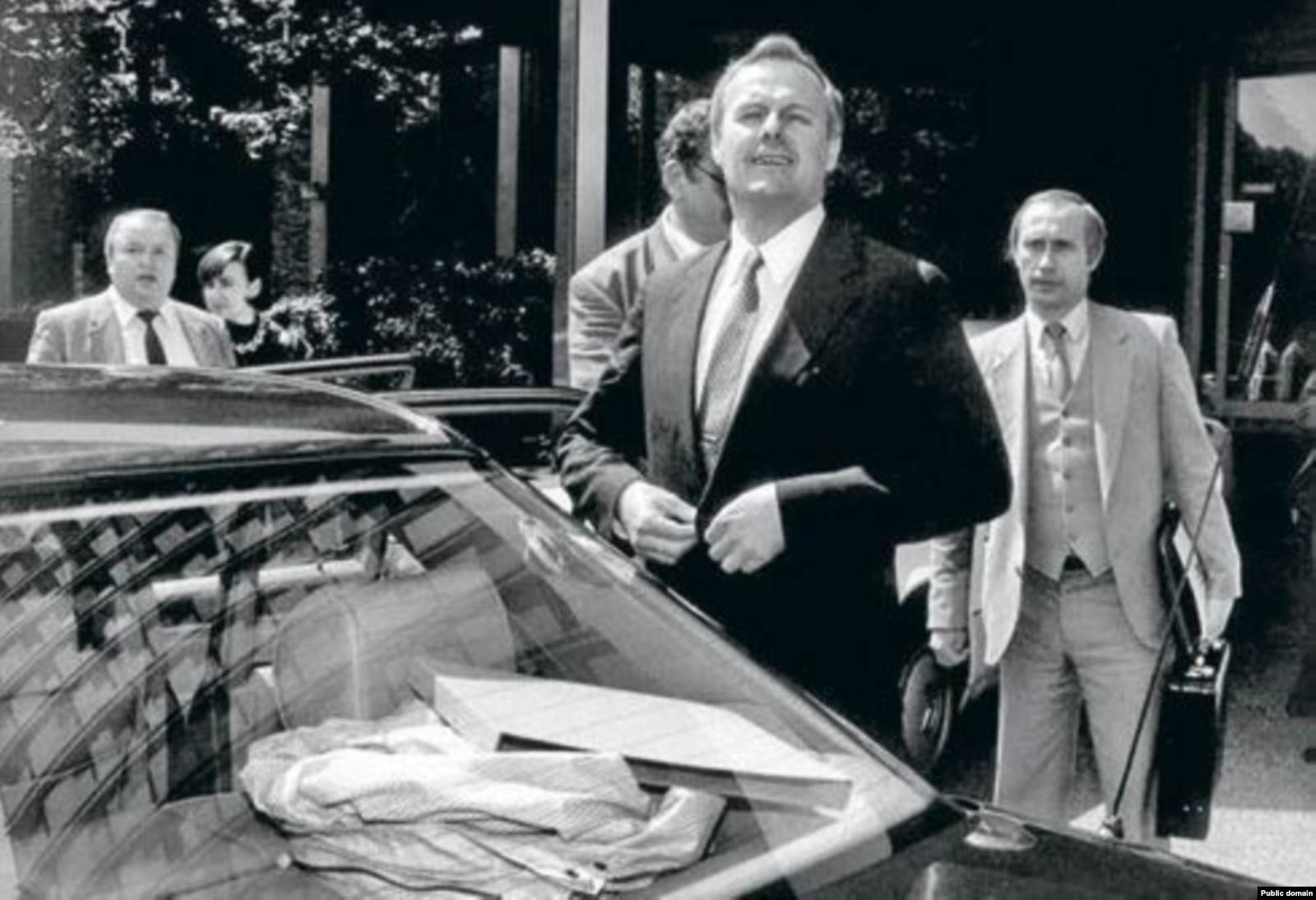
The article quoted two Alkor executives as saying that middlemen had offered between $200,000 and $300,000 per kilogram to purchase up to 500 kilograms of red mercury per month. The Alkor sources said they did not know the identity of the ultimate purchasers of the purportedly deadly substance, but that they believed they were "Arab firms."
Food shortages were rampant in the Soviet Union and the newly independent states that emerged when it collapsed in December 1991, including Russia. A reform introduced in April 1991 caused prices for basic foods to rise from two to five times virtually overnight. Store shelves were stripped bare. By the end of 1991 many cities, including the newly renamed St. Petersburg, were facing the real prospect of famine.
The government decided to cope with the crisis by allowing the limited export of commodities like oil and rare-earth metals to raise funds to purchase foreign food supplies. The plan was for the government to authorize export quotas after Russian firms and local governments identified reliable foreign partners. In reality, however, the commodities often left the country -- but the food never arrived, and the money vanished.
"We learned unofficially that at a special session of the [Russian] government, our city had been granted quotas to barter with Western firms -- for metals, timber, oil products in exchange for food," former St. Petersburg lawmaker Marina Salye told journalist Vladimir Ivanidze in 2000. "Putin oversaw this. Time passed. Contracts were signed. Commodities were exported. But the food didn't come. It never came."
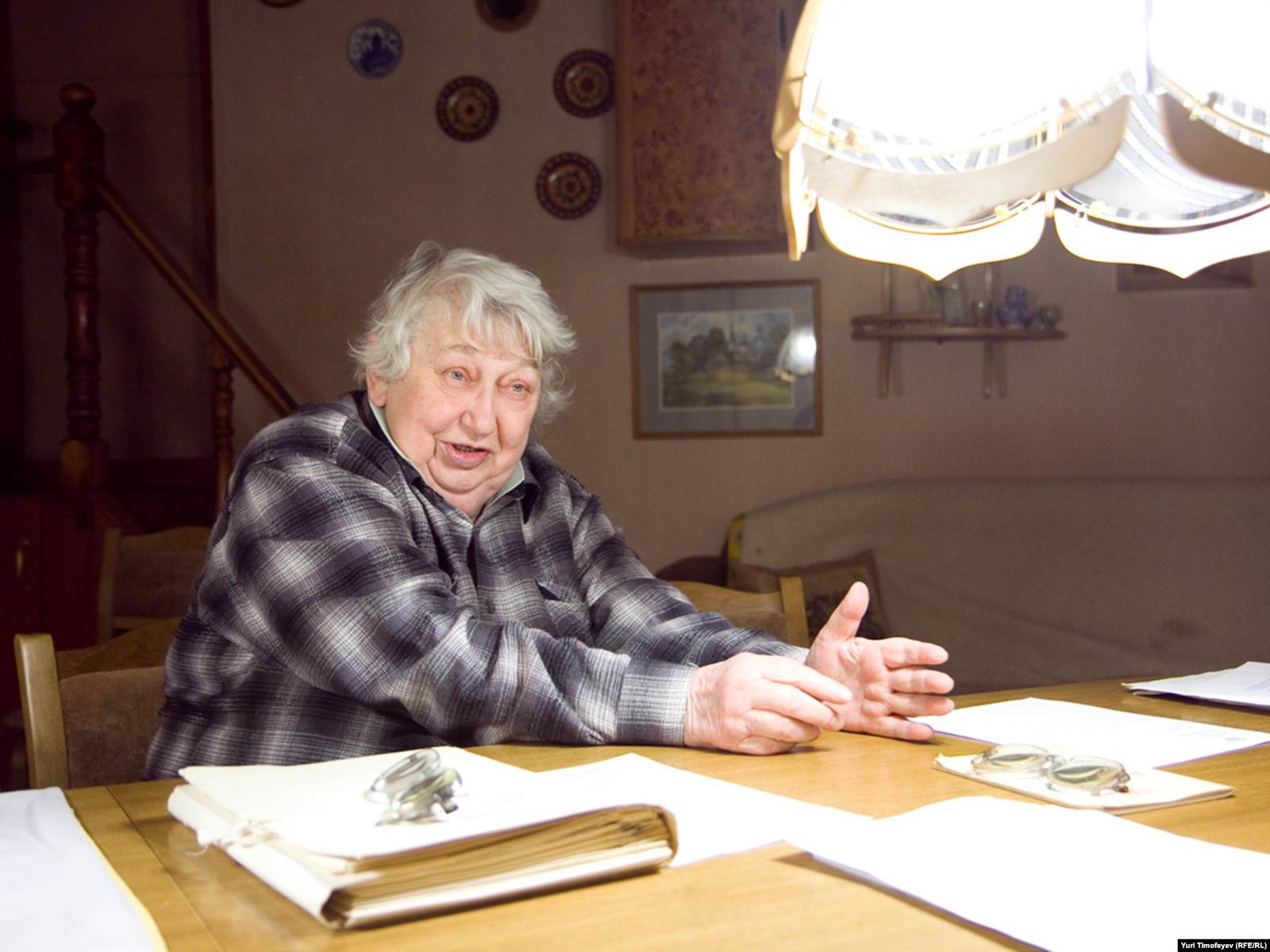
Later, Salye and fellow lawmakers conducted an investigation into Putin and the KVS in which they determined that millions of dollars had disappeared because Putin's committee awarded export quotas to murky companies that disappeared as soon as the money landed in their accounts. The lawmakers urged a criminal investigation and asked Mayor Sobchak to fire Putin and his deputy, Aleksandr Anikin.
But nothing was done.
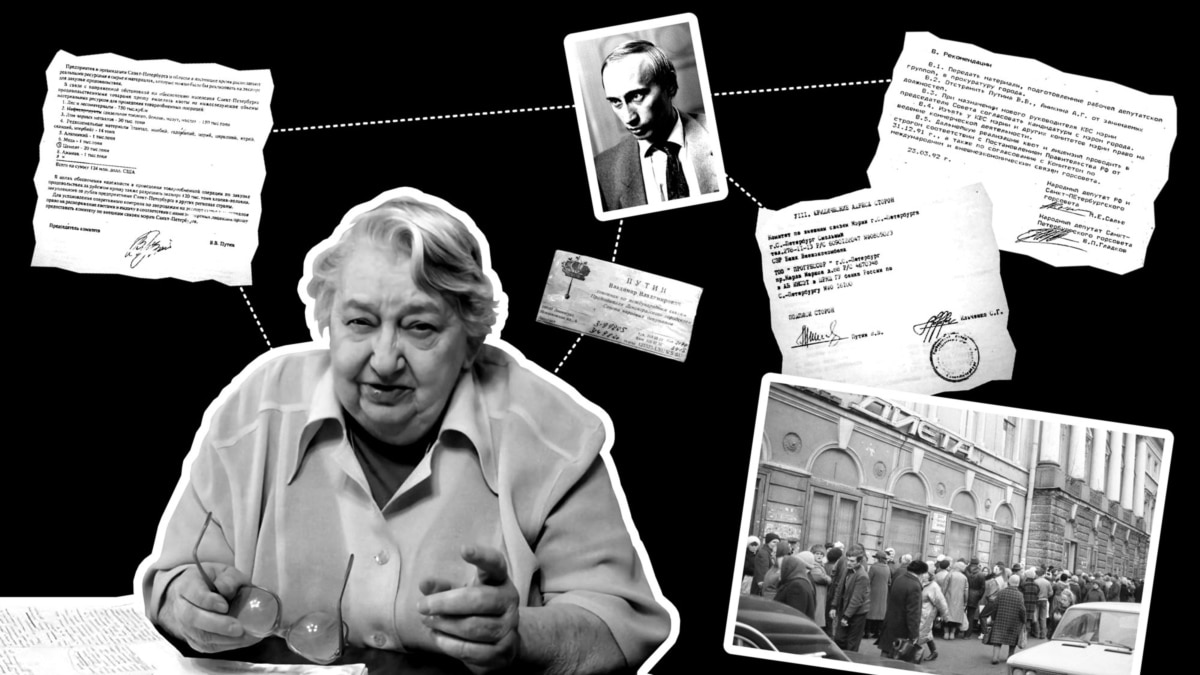
Marina Salye
The St. Petersburg Lawmaker Who Became Putin’s First Accuser

'The Last Great Swindle Of The 20th Century'
No one knows how the myth of red mercury began. There is no consistent account of exactly what it was supposed to be or do. It was supposedly a deadly substance developed in a super-secret military laboratory in the waning days of the Soviet Union.
Some said it was the key to the next generation of powerful nuclear warheads. Others said it was a nuclear weapon itself. Still others claimed it was the secret ingredient in high-tech guidance systems, while a fourth version asserted that it was vital to the anti-radar coating of stealth aircraft and ships.
Sometimes it was described as a powder, or sometimes as a liquid or a gas.
The only characteristics that all the stories had in common was that red mercury had a reddish color and that it was fantastically expensive.
In 1991-92, dozens of hucksters and entrepreneurs bombarded the Russian authorities with requests to export the substance, claiming that they were able to produce it themselves or had reliable connections with those who could -- and that there were rich foreign customers ready to buy it. All they needed were export quotas and the country's food problem would be solved.
The letters and other red-mercury-related documents from this era were collected in a book by Aleksandr Gurov, a former police general who became a Russian legislator and who, together with investigative journalist Yury Shchekochikhin, published the first scandalous exposés on organized crime in the last years of the Soviet Union.
From 1992 to 1994, Gurov headed the Russian Interior Ministry’s anti-corruption bureau and was a member of its special panel on red mercury, which the commission called "the last great swindle of the 20th century."
Government bureaucracies responded variously to these letters. The KGB and its Russian successor insisted the Soviet Union never produced red mercury, as did the Defense Ministry. The Academy of Sciences and the Atomic Energy Ministry insisted no such substance existed. But the hucksters responded with the conspiracy theory that the "deep state" was trying to hide this miraculous substance even from Russian President Boris Yeltsin.
In October 1992, a special commission headed by Vice President Aleksandr Rutskoi ordered all government agencies to stop considering requests to export red mercury and stated definitively that the substance simply did not exist.
"We can assume with certainty that under the cover of deals involving 'red mercury,' massive international financial machinations are being carried out," the commission's report asserted. "It is possible that under the guise of 'red mercury,' valuable strategic materials (platinum, gold, osmium, indium, uranium, plutonium, and others) were exported."
A February 1992 warning issued by the U.S. Department of Energy, meanwhile, cautioned that con artists were attempting to dupe buyers with fantastical claims about red mercury. "After careful consideration of the claimed physical properties of the alleged material, it became apparent that 'Red Mercury' does not exist," the warning stated.

The Rutskoi commission listed five companies that were "most active" in promoting the red mercury scam -- Simako (Moscow), Promekologia (Yekaterinburg), two firms tied to the Foreign Economic Relations Ministry, and Ekoprom (Moscow).
Promekologia, led by a colorful entrepreneur named Oleg Sadykov, had even successfully lobbied Yeltsin to sign a secret decree in February 1992 granting the firm permission to produce and export to 10 metric tons of red mercury annually. In December of that year, Sadykov delivered 5 kilograms of "red mercury" to a Russian customs laboratory for examination. The analysis found the substance to be a mixture of ordinary metallic mercury and mercury oxide, which gave the compound a brick-red color.
The St. Petersburg-based Alkor -- though its executives had boasted in the press about their ability to produce red mercury, placing the company at the heart of the frenzy over the mysterious substance -- was not mentioned in the Rutskoi commission's report.

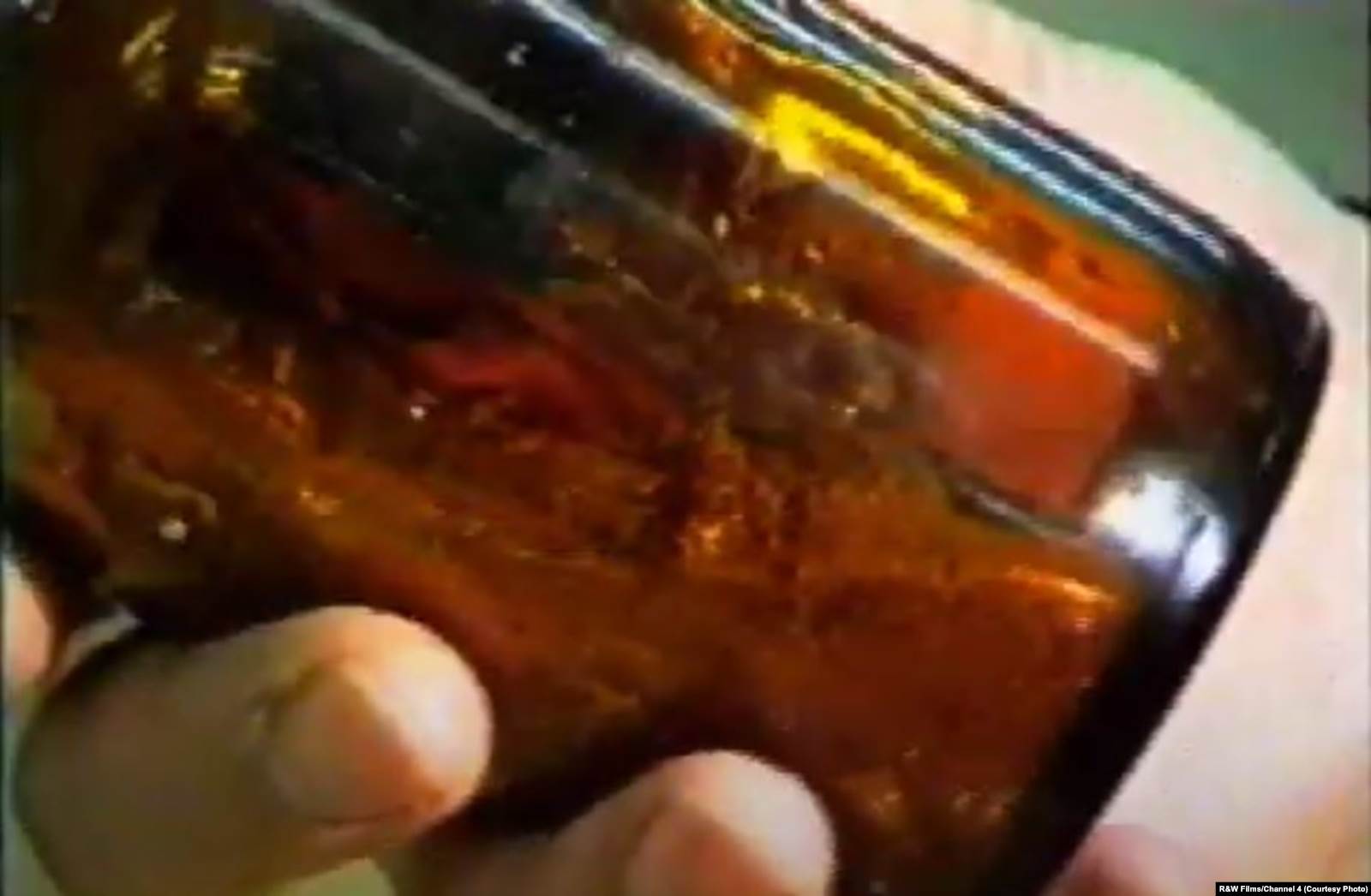

$1 Billion
The Alkor story began in the late 1970s, when a group of students became friends on Komsomol work projects in remote regions. At the time, young math and physics students from Leningrad State University could earn 1,000 rubles -- about one-quarter of the cost of a low-end Soviet car -- by spending the summer hauling logs and building barracks in Yakutia, Komi, and other corners of the country.
In 1987, several such students formed a cooperative called Orion. At first, Orion was in the business of constructing the summer cottages known as dachas, but it soon branched out into a range of new pursuits, from laser technology to leasing cargo ships. At one point, the cooperative boasted 500 employees.
By the early 1990s, the cooperative had become so diversified that the original partners decided to split it up. The slimmed-down Orion was run by three former physics students and specialized in technology-related projects. In February 1990, the cooperative created the joint venture Alkor with an American firm called North Shore Trade Enterprise Incorporated. Kommersant described North Shore as "a leading distributor of components for spectrometers on the U.S. east coast."
According to U.S. records, North Shore was headed by Vladimir Rodov, a scientist who got his doctorate in Moscow in the 1960s. After emigrating to the United States, he worked for a number of leading technology firms and was awarded more than 20 patents, mostly in the field of semiconductors.
In the early days, Alkor specialized in producing optical glass, but it was soon looking to expand into other areas. And it did so with the support of the St. Petersburg government, becoming one of the pioneers of the red-mercury scam.

In the Kommersant article written after the red-mercury raid in Czechoslovakia, Alkor head Ivan Kuznetsov said the company was already in a position to export large quantities of the substance. He claimed the exports could be worth about $1 billion.
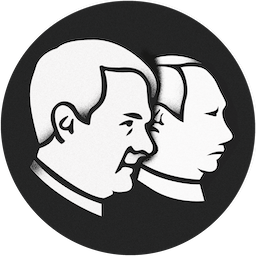
The Third Partner
But there was a third element to the scheme. A new legal entity, the joint-stock company Palmer, was created for the red-mercury project. Alkor owned 52 percent of Palmer, while a U.S. firm called Scientific Ventures Group owned 32 percent. RFE/RL was not able to find any information about Scientific Ventures Group except that it was registered in Maryland in April 1991 and its "resident agent" was someone named Elda Mikhaylova.
The remaining 16 percent of Palmer belonged to the St. Petersburg External Relations Committee (KVS), chaired by Putin.
Alkor deputy director Ramaz Tadeyev told Kommersant that the inclusion of Putin's committee in the project was seen as "a sort of guarantee of the legal protection" of the red-mercury project.
While Putin was able to distribute export permits for timber, oil, and other commodities easily under authority granted by the Russian government, the matter of permission to export a supposedly dangerous substance like red mercury was more difficult.
In November 1991, the head of the agency inside the Foreign Economic Relations Ministry that oversaw the assignment of export quotas, Oleg Prasolov, wrote an instruction to the state licensing agency to issue permission to export 400 kilograms of red mercury produced by Alkor to Hungary for the sum of $30 million. Attached to his letter was an expert analysis of Alkor's red mercury by the Academy of Sciences' Institute of General and Inorganic Chemistry.
The institute concluded, after studying a sample, that Alkor’s red mercury was ordinary mercury pyroantimonate -- which to this day is sometimes informally called "red mercury" because of its vermillion hue. Mercury pyroantimonate is used in a number of manufacturing processes and can be purchased for about $3,000 a kilogram.
Alkor’s red mercury "does not have military applications," the institute concluded. On the basis of this conclusion, Prasolov argued that exporting the substance did not require any special licensing.
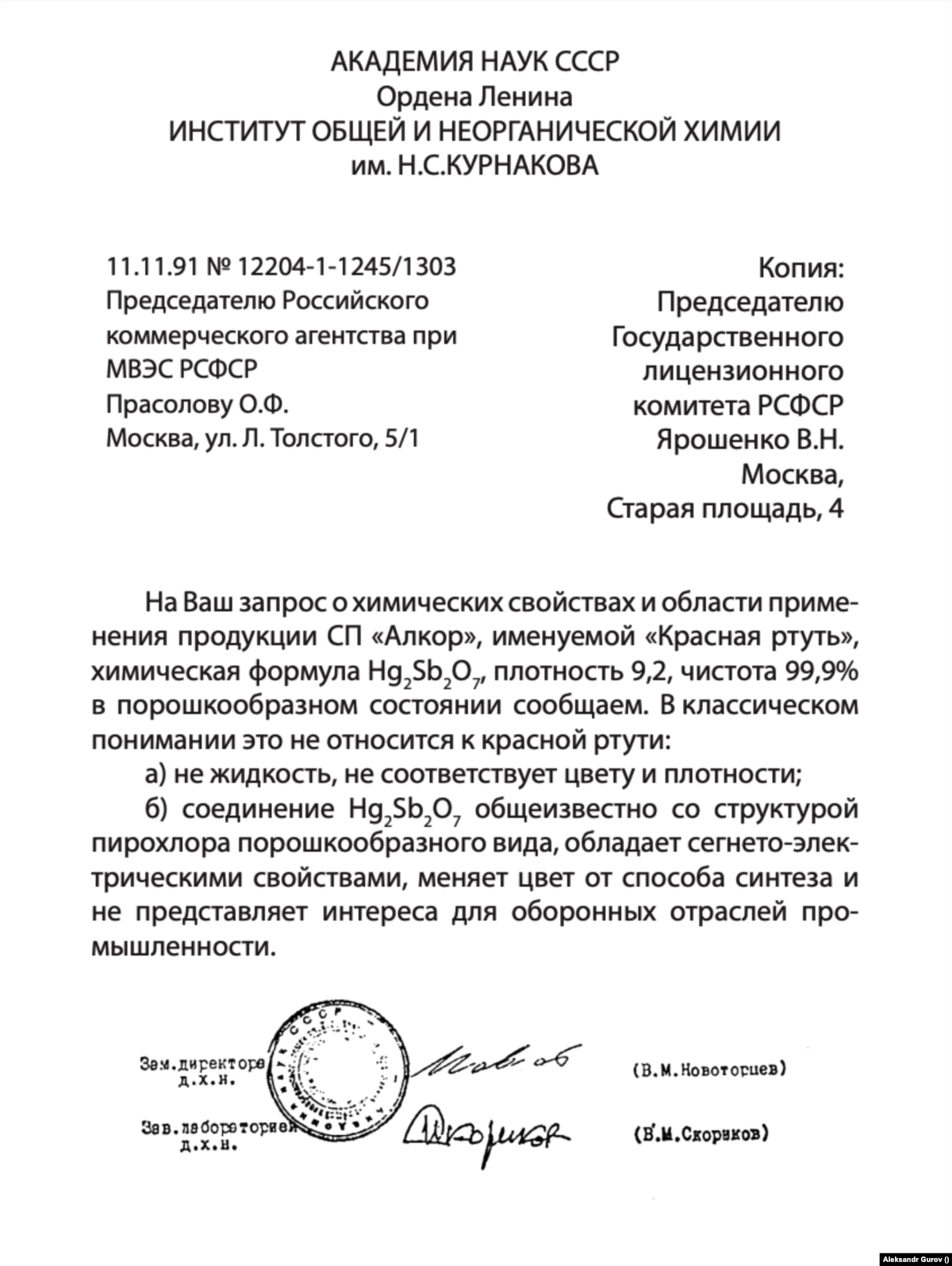
Apparently, Prasolov's letter did not have the desired effect because in January 1992, the state licensing agency received another letter about Alkor -- this time from the St. Petersburg KVS. The letter, which was signed by Putin's deputy, Anatoly Karasev, asked the agency to grant Alkor a license to export red mercury.
In mid-March, Prasolov wrote another letter, complaining about the "long time" it was taking to issue the license and asking for the process to be expedited. He attached the letter from Putin's committee to his appeal.
RFE/RL has not been able to establish whether Alkor ever exported any of the mercury pyroantimonate that it was touting as a mysterious super-substance.

Whether it ever intended to do so is also unclear. Already in the early 1990s, experts were connecting red-mercury claims with various scams, including the export of commodities like uranium or other radioactive elements. Other analysts suspected purely financial scams. For instance, foreign customers could be required to make a down payment in hard currency while the contract would specify the penalty for nonfulfillment be paid in rapidly devaluing rubles. Such contracts offered enormous possibilities for fraud.
Alkor continued making its red-mercury claims right up until the Rutskoi commission laid the myth to rest, at least in the eyes of the state. In October 1992, just weeks before the commission released its report, Britain's Sunday Times published an article about the mysterious Soviet invention.
The article noted that many international scholars and institutions had denied the existence of red mercury, but also presented the views of several "independent" experts who claimed there was a conspiracy to conceal information about the substance. One of those experts was Alkor's Tadeyev, presented as the scientific director of a "flourishing company in St. Petersburg." He insisted Alkor was producing red mercury.
"It can be used to make a nuclear weapon," he told the newspaper. "That's why the prices are so high."
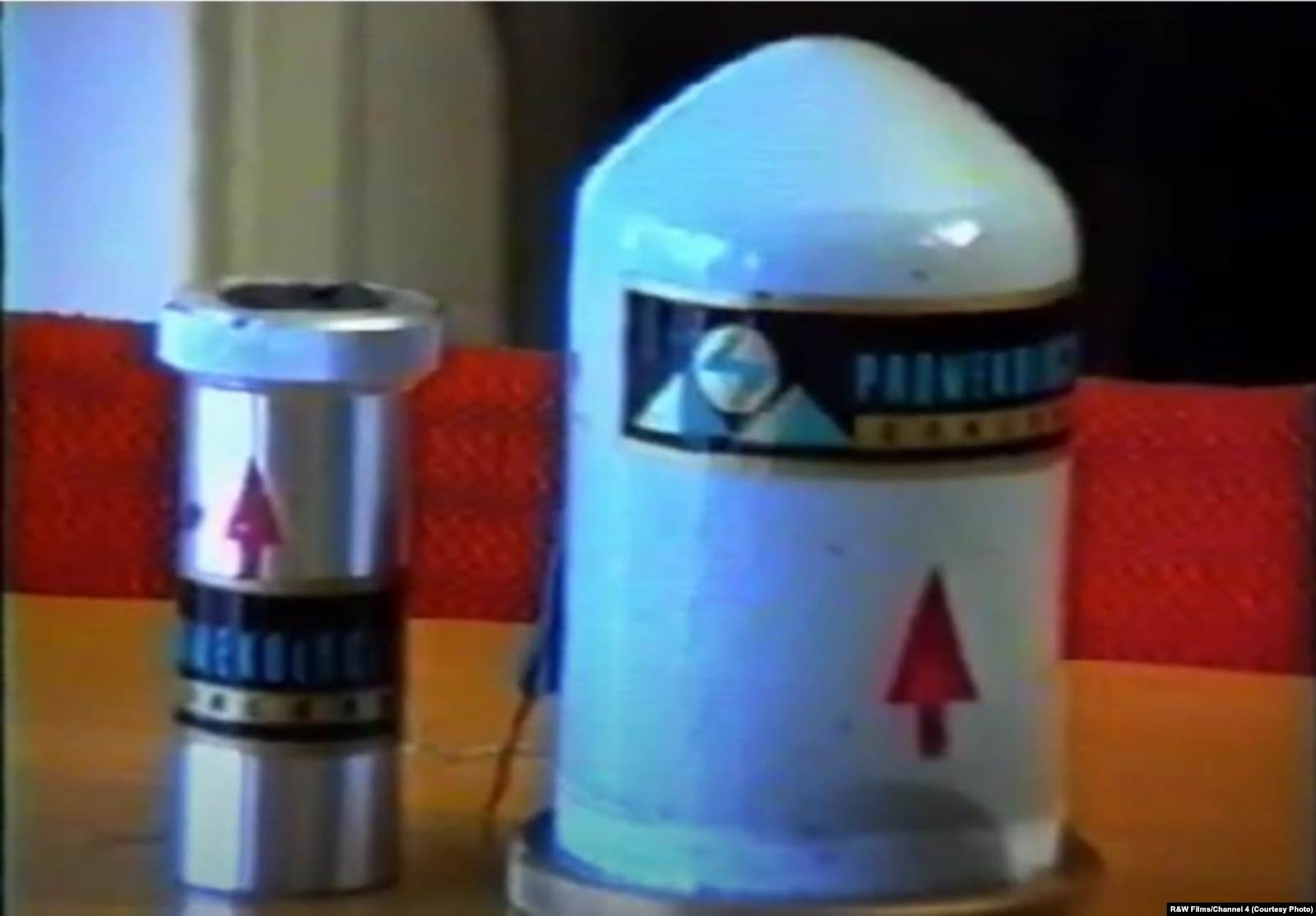
In the wake of the red-mercury saga, Alkor's founders went on to new successes. Ivan Kuznetsov and Oleg Zakharzhevsky founded the Tavrichesky Bank in 1993. According to the St. Petersburg website Fontanka.ru, they used a car as the bank’s founding capital.
The bank grew rapidly and attracted major corporate clients. The largest of these was Lenenergo, the municipal utilities company. The company held enormous sums in accounts at the bank and its employees were issued Tavrichesky bank cards to handle their salaries.
The bank expanded rapidly, opening in Moscow and throughout the Leningrad region. In the town of Sosnovy Bor, which is dominated by the Leningrad Nuclear Power Plant, Tavrichesky Bank serves 65 percent of the population. In 2014, it was listed as the 105th-largest bank in Russia and the sixth-largest in the northwest region.
However, it fell victim to the financial crisis of 2014. It was examined by the central bank, but no major shortcomings were revealed. Nonetheless, by early 2015, Lenenergo employees were reporting delays in getting their salaries. A new central bank inspection found some 36 billion rubles ($520 million) missing, including more than 13 billion ($200 million) from Lenenergo accounts. Since 2015, Tavrichesky Bank has been in state-mandated receivership under MFK Bank.
MFK discovered that Tavrichesky had a history of extending loans to its shareholders and their companies. Alkor had been given a 150 million-ruble ($2 million) loan, while Kuznetsov had personally borrowed 5.3 million rubles ($76,000). Kuznetsov and Zakharzhevsky avoided prosecution, but MFK sought a bankruptcy order for Kuznetsov and Alkor's office building was seized. Bankruptcy proceedings have also been initiated against Zakharzhevsky.
Kuznetsov and Zakharzhevsky did not respond to requests to be interviewed for this article.
Alkor Technologies, which has had no connection with Kuznetsov or Zakharzhevsky since 2006, still exists and produces infrared optical components for major international clients.
Three decades after the collapse of the Soviet Union, scandals involving red mercury continue to pop up from time to time. In March 2019, four men were arrested in Kyiv for allegedly trying to sell 2 liters of a substance they said was red mercury for nearly 250,000 euros ($263,000).
